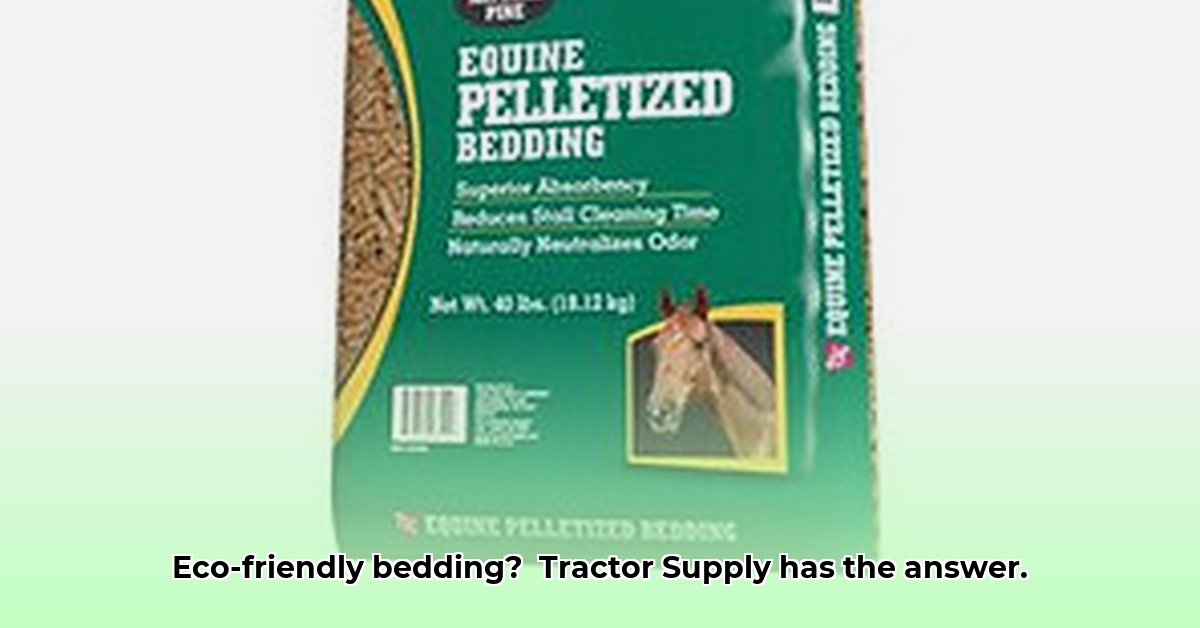
Choosing the right bedding for your horse isn't simply about comfort; it's a crucial aspect of responsible equine management and environmental stewardship. This guide explores the eco-friendly bedding options available at Tractor Supply, focusing on horse bedding pellets and their sustainability benefits compared to other choices. For more on responsible pet care, check out Tractor Supply resources.
Exploring Your Bedding Options at Tractor Supply
Tractor Supply offers diverse bedding options, each with unique advantages and disadvantages concerning cost, absorbency, waste management, and environmental impact. Let's compare the most common types:
Pine Shavings: A traditional favorite, pine shavings are widely available, relatively inexpensive, and absorbent. However, they require frequent mucking, generating substantial waste and potentially impacting your long-term budget due to frequent replacement. Their environmental impact depends on sustainable forestry practices, and improper disposal contributes to landfill burdens. Aren't there more sustainable alternatives?
Horse Bedding Pellets: These compressed pellets expand upon absorbing moisture, leading to less frequent changes and reduced waste compared to shavings. Many are made from recycled materials, further enhancing their eco-friendliness. While the initial cost may be higher, the reduced replacement frequency often translates to long-term savings and a smaller environmental footprint. Do you find this trade-off worthwhile for the convenience and sustainability gains?
Recycled Paper Bedding: This highly absorbent bedding boasts excellent sustainability credentials and is easily composted. However, it might be more expensive and availability may be a limiting factor depending on your location.
Straw: A readily available and inexpensive option, straw's low absorbency and potential for pest harboring outweigh its cost-effectiveness. Waste management can be challenging, impacting its environmental sustainability.
Hemp: Absorbent and naturally antimicrobial, hemp bedding is compostable but commands a higher initial cost and availability might vary. Its sustainability depends heavily on cultivation and processing methods. Are you willing to pay a premium for the added convenience and eco-friendly features of hemp bedding?
| Bedding Type | Pros | Cons | Environmental Impact |
|---|---|---|---|
| Pine Shavings | Widely available, relatively affordable, absorbent | Generates significant waste, frequent changes needed | Depends heavily on sustainable forestry; proper disposal is crucial. |
| Horse Bedding Pellets | Less waste, efficient use, often made from recycled materials | Might be more costly upfront | Sourcing and processing methods are key; look for transparent information and certifications. |
| Recycled Paper Bedding | Very absorbent, sustainable source materials, easily composted | Possibly higher cost, limited availability | Generally considered highly sustainable; ensure proper composting. |
| Straw | Readily available, inexpensive | Less absorbent, may harbor mold or pests, significant waste | Sourcing matters; consider locally grown options; disposal can be challenging. |
| Hemp | Absorbent, naturally antimicrobial, compostable | Higher initial cost, availability might vary | Growing and processing methods significantly impact sustainability; check certifications. |
Creating a Sustainable Stable: Practical Tips
Sustainable horse care involves conscious choices. Here are actionable steps to minimize your environmental impact:
Optimize Bedding Usage: Use only the necessary bedding; avoid over-bedding. Spot-cleaning and regular mucking extend bedding life, reducing waste and saving money.
Embrace Composting: Composting horse manure and bedding reduces landfill waste and creates valuable fertilizer. Ensure proper composting techniques (layering, moisture, aeration) for efficient decomposition.
Reduce Waste Through Efficient Mucking: Employ effective mucking techniques to minimize bedding consumption. Explore reusing safe, usable materials.
Selecting the Best Bedding for Your Horse
The best bedding depends on your budget, horse's needs, and environmental priorities:
Absorbency: Crucial for maintaining a dry and comfortable environment. High absorbency reduces frequent changes.
Waste Management: Easily composted bedding simplifies disposal and reduces environmental impact.
Cost: Balance initial purchase price with long-term replacement and disposal costs.
Environmental Responsibility: Prioritize sustainably sourced materials and responsible processing methods. Check for certifications and transparency from your supplier.
Tractor Supply's horse bedding pellets often offer a good balance of these factors. However, the optimal choice depends on your unique circumstances.
The Ongoing Quest for Greener Stables
While sustainable options like horse bedding pellets are improving, further research is vital. Standardizing sustainability metrics and conducting Life Cycle Assessments (LCAs) will provide a clearer picture of each bedding type's true environmental impact, furthering responsible horse care practices. "The lack of standardized metrics hinders the industry's progress toward truly sustainable solutions," notes Dr. Emily Carter, Equine Environmental Science, University of California, Davis.
Comparing Costs of Equine Bedding and Waste Disposal Methods
Choosing bedding involves a cost-benefit analysis. While pine shavings are initially cheaper, the frequent replacements and waste disposal costs can outweigh the initial savings. Pellets might be more expensive initially, but the reduced waste and potentially lower landfill fees could lead to long-term cost savings. Conducting a thorough cost-benefit analysis pertinent to your situation is crucial.
Sustainable Waste Management: Composting and Beyond
Composting offers a responsible waste disposal method and reduces landfill burdens. Proper techniques involving layering, moisture control, aeration, and regular turning are critical for effective decomposition.
Minimizing Waste: Smart Bedding Management Strategies
Efficient mucking techniques, using the appropriate amount of bedding, and proper layering contribute to significant waste reduction, leading to both cost and environmental savings.
Making Informed Choices
Consider your budget, time commitment for waste management, and environmental impact when choosing bedding. Even small changes can have a significant cumulative effect on your stable's environmental footprint.